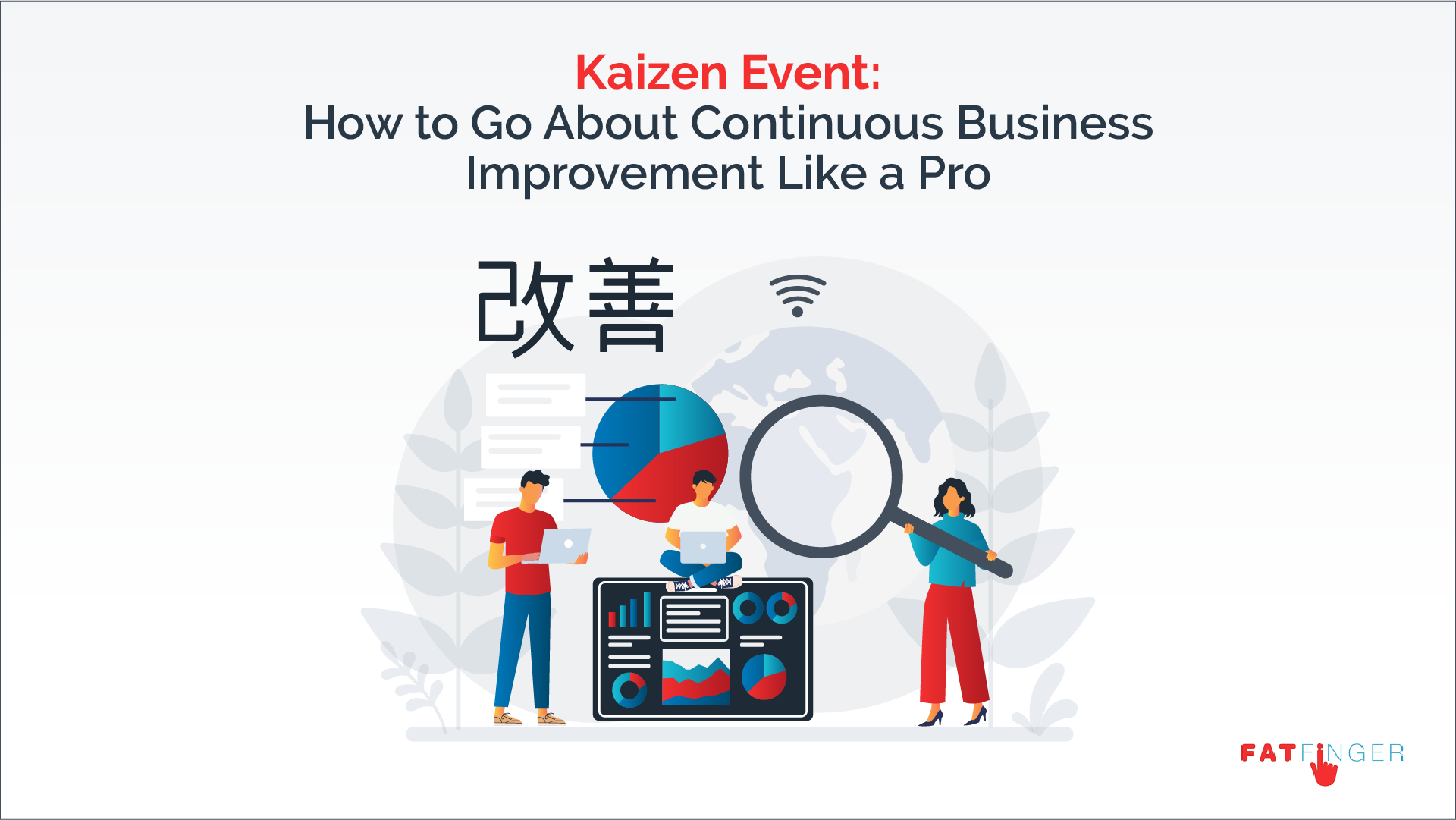
As modern-day humans, we relish self-improvement. It’s why each New Year — and in many cases each quarter, month, or even every week — we set ourselves goals so we can become better, bolder people.
But improvements, of course, aren’t only relegated to people.
In a business context, what about the workflow processes your team use day in, day out? The protocols that have been carefully established? The systems used so necessary end-results can be achieved? To stop stagnation in its tracks, these need to be leveled up and improved over time too so your business can be the best it can be.
That’s why, in this informative FAT FINGER blog post, I’m going to tell you everything you need to know about the all-important Kaizen Event.
(Think of Kaizen Events as the business world’s equivalent of New Year resolutions — though in this instance they happen far more regularly, and solutions to problems are always found.)
All you need to do is make your way through these sections:
- What is Kaizen?
- What is a Kaizen Event?
- The business benefits of hosting regular Kaizen Events
- Preparing for your first Kaizen Event
- Use FAT FINGER to master processes and Kaizen Events alike!
Let’s get straight into it.
What is Kaizen?

Kaizen (‘Kai’ = ‘Change’, ‘Zen’ = ‘Good’) is the Japanese business concept of continuous improvement.
Simply put, it’s a philosophy — a state of mind, if you will — that prioritizes the elimination of waste and redundancies in business activities, and particularly business processes. It’s a commitment to never letting old, outdated, and outright bad business processes get in the way of good business from happening.
Perhaps you’ve heard of Kaizen before, and I wouldn’t be surprised if that’s the case. Kaizen has become a worldwide phenomenon that’s used by teams in every industry. From manufacturing to construction, commerce to mining.
Here’s why.
In the 1940s, and just after World War II, American business and quality management teachers inspired the folks working at Toyota. The Toyota employees came to understand that, when manufacturing cars — objects that required a lot of materials, time, and effort — having quality circles throughout the production process ensures the end result is always up to par. It saves them money, labor, and a lot of time in the long-run. Not to mention, it stops teams from uncovering nasty surprises only once the products were in the hands of consumers.
From the 1950s onwards, quality management and continuous improvement didn’t just grip employees at Toyota; it gripped the Japanese business world-at-large.
Japanese business theorists and practitioners, like Masaaki Imai, built on American ideas and helped spread the word about the business-altering positives of solid quality management, improvement, and change.
The effectiveness of Kaizen can be seen with one look at Toyota; the Kaizen-founding, lean management-fixated company that we can thank for taking business improvement steps to the next level. In the modern-day, there’s not a place you can’t buy a Toyota car. Plus, they’re some of the most robust, well-made products ever!
Needless to say, Kaizen is important, useful, and necessary. And the good news is that you don’t have to be a car manufacturer to reap the rewards of Kaizen.
You can be in any industry!
What is a Kaizen Event?

A Kaizen Event is a 3 to 5-day long project where a specific group of people from a team get together to solve a business problem.
The problem in question could be a process that is in dire need of updating, a recurring issue like low conversions in marketing content, or faults that keep cropping up during the production process itself. It can be anything, really, as long as the problem is somewhat urgent (i.e., it’s a noticeable problem) and, ideally, related to a process.
Essentially then, a Kaizen Event is dedicated, allotted time to undergo continuous improvement and solve some tricky business problems. It’s all about making space in a team’s busy calendar to tackle issues and stop them from getting out of hand. Otherwise, teams may never get around to making the necessary changes that need to be made.
What’s important to know is that Kaizen Events are for incremental improvements that will have a significant impact. It’s not about kicking off big, mammoth process and system projects. Kaizen Events are small-scale in the grand scheme of things, and provide a window for teams to tap into continuous improvement without having to royally shake things up.
That’s what a Kaizen Event is in a nutshell.
But how do you do Kaizen in a Kaizen Event? What steps are taken? Is there a recommended approach to take?
In short, yes; there is an approach.
And if it’s led by somebody who’s had prior training, then it can be an incredibly smooth and simple event.
What does a Kaizen Event consist of?

On the first day, the group will get together — and the group should be a mix of people who are all in control of, use, or oversee the process in question.
The leader will use this first day to get everyone up to speed on what Kaizen is, what a Kaizen Event is, the schedule for the Kaizen Event project, and what will be done. Training can also be provided regarding Kaizen, lean methodology, and waste in business.
The second day will primarily involve looking at the documented process, running it, and figuring out where bottlenecks, waste, and any other problems occur. (It’s here where lean tools like DMAIC, PDCA, and 5 Whys are used.) The group will also gather data on how the process is currently performing, and benchmarking it against any previously collected data.
The third day concerns solving the problem(s). How can it be rectified? Will the solution have any knock-on effects? Will it impact the rest of the process? Will it be harder to improve the process next time? Is it a quick fix or a long-term solution? To help groups figure out which solutions are, well, solutions — and not duds — they’ll most likely test their ideas out at this stage, too.
After some brainstorming, discussion, and testing, the group will then get to the implementation phase of the Kaizen Event. This means directly changing the process with the suspected improvements. It can be the case that unexpected surprises occur, so this part of the Kaizen Event is often the hardest.
The final part of any Kaizen Event is reflection. How was the process changed? Could similar changes be applied elsewhere? Has waste, redundancies, or bottlenecks been uncovered anywhere else? Do the rest of the team need to know about what’s changed? These questions — and many others like it — will be answered before the group members all go back to their desks and do what they do best. A report may be drawn up too, and the next Kaizen Event scheduled in the calendar.
Keep in mind the above approach assumes that the Kaizen Event takes place in a 5-day span.
For you, it could be shorter or even a little longer, which means different activities take place on different days.
Either way, a Kaizen Event is an incredibly value-rich activity that all teams should be getting involved in!
The business benefits of hosting regular Kaizen Events

It’s safe to say that you wouldn’t be reading this article if there weren’t any substantial benefits that come from Kaizen Events — and I wouldn’t have written this short guide on Kaizen Events, either. We’d be elsewhere, doing something more valuable with our time.
But the fact of the matter is that Kaizen Events can help transform a business from one that’s just about trucking along into one that’s a slick, well-oiled machine.
Specifically, holding and facilitating regular Kaizen Events means:
- Scheduling time to work on continuous improvements.
Meetings. Presentations. The myriad other work-related activities that take up your time. In each person’s workday, there’s a lot of things that are vying for attention, and it makes it incredibly easy for us to push important activities further and further back. But by scheduling a Kaizen Event in your and the relevant colleagues’ calendars, you’re making a conscious effort to focus on what’s important in the long-run: Making improvements and solving pesky business-altering problems.
- Solving business problems, issues, and quandaries — repeatedly.
While, yes, there are countless short-term, medium-term, and long-term positives that come from undertaking Kaizen Events, it’s first and foremost a vehicle to stop businesses from failing. Rather than letting bad processes, protocols, and systems fester and drag your business’ bottom-line down with it, you and your team are repeatedly bolstering them, making them better than they’ve been before, and ensuring their usefulness and success going forward.
- Establishing a culture of improvement.
Today’s modern and hectic business world means there’s little chance to reflect on what isn’t working and what could be improved — especially if everything seems rosy for the time being. Sooner or later though, a problem will occur if no attention is paid to improvements and problem-solving. The good news is that regularly hosting internal Kaizen Events means your team has a culture of improvement, where they’re aware and ready to make improvements to solve any current problems or problems that could occur in the future.
- Fostering team-wide communication and collaboration.
I don’t know about you, but I always work best in collaborative group settings. It’s there where I have my best ideas, and together, the group and I can come up with something actionable and exciting. Those who hold regular Kaizen Events get to experience this time and time again, and in scenarios that directly help the business overcome any problems that it’s facing. Plus, if the group is composed of people who don’t know each other all too well or don’t interact regularly, then even better! They get to communicate, collaborate, and conquer together.
I could go on and on, listing the benefits of Kaizen Events left, right, and center. But for the sake of brevity and your time, I’m stopping here.
By now, I’m sure you’re raring to get started with having your team’s very first Kaizen Event. After all, who wouldn’t want to reap the above rewards?
To help you get going, here’s a handful of helpful, must-know tips.
Preparing for your first Kaizen Event

By reading the earlier What does a Kaizen Event consist of? section, you’re up to speed regarding what happens during a Kaizen Event. You know how they begin, what’s at its core, and what occurs during its final stages.
But what are some ways to prepare for Kaizen Events — particularly your team’s very first?
Let’s take a look.
Confirm who’s leading the Kaizen Event
The Kaizen leader is the person at the helm of a Kaizen Event; the person who essentially leads the team to victory. It’s imperative that each Kaizen Event has a leader and it isn’t just a free-for-all; otherwise, there’s a very good chance that efforts will constantly veer off course.
The Kaizen leader shouldn’t just be anyone, though. It should be somebody who’s been trained to facilitate such workshops, somebody who’s knowledgeable when it comes to lean methodology and lean tools, and somebody who’s good at navigating teams.
If you’ve already got somebody like this within your ranks, then perfect! If not, why not send an appropriate colleague on a Kaizen course? It’ll benefit them, and then it’ll benefit your entire business.
A win-win situation if there ever was one.
Get support from the top
Both Kaizen and Kaizen Events are exciting, right?
Right!
But what do the C-suites and executives think about running Kaizen Events? Have they even heard of such a thing before?
Before setting up a Kaizen calendar event for your team, ensure you’ve got the necessary support from the top. Not only will their outward display of support get other team members engaged in Kaizen projects, but you may also need them to help with necessary resources, like Kaizen training.
Luckily, by presenting the cold, hard facts about Kaizen and Kaizen Events, it shouldn’t be difficult to get them on board.
Set the first Kaizen Event’s boundaries
Now, this is a tip that concerns all of your Kaizen Events going forward, but it’s particularly important for the very first Kaizen Event you’ll be holding.
Before the first day of the Kaizen Event arrives, you — or the Kaizen Event leader — will need to set Kaizen Event boundaries. By ‘boundaries’, I mean the basic information concerning the event. Who needs to attend? When? Where, and for how long? These are the basics to get started with.
Then, move onto more robust questions like, what marks the Kaizen Event as successful — i.e., what specific metrics would you like to see after changes and improvements have been made? An improved process completion time, perhaps? Or a higher number of conversions? And what is the main problem that the Kaizen Event will focus on?
Essentially, some setup is required before steaming ahead.
Gather the right people
Following on from the previous paragraph — specifically, the part about answering the question of who needs to attend the Kaizen Event — you’ll want to gather the right people.
The operative word here, though, is “right”.
While you can gather any group of folks for a Kaizen Event, you’ll want to be intentional about who you choose to invite.
Let’s, for instance, say there’s a problem with safety inspections that you’d like to stamp out. A safety inspection checklist is being used, but minor accidents still happen on occasion. In terms of who you want to attend the Kaizen Event, you’ll want the people who use the checklist frequently, the people who wrote the checklist, and members of staff who are knowledgeable when it comes to on-site health and safety matters.
Ergo: You need a good, solid mix of people that can bring in different insights, ideas, and experiences.
Ideally, the group will be between five and ten people.
Ensure relevant processes have been documented
Before your Kaizen Event group gets going, ensure that the process you’ll all be looking to improve is documented.
In fact, it’s best practice to have all of your team’s recurring processes documented properly. Not just so they’re there for Kaizen Events, but they’re there whenever colleagues need to follow them.
From safety inspection checklists to manufacturing processes, asset inspections to field services, having important processes documented — and allowing employees to follow them — means risk is reduced, quality is secured, tasks are done faster, and people always know what they should be doing.
To make Kaizen Events and pretty much every other aspect of your business’ life easier, it’s time to get acquainted with FAT FINGER.
Use FAT FINGER to master processes and Kaizen Events alike!
FAT FINGER is a software platform that enables teams to digitize their essential processes, procedures, workflows, and operations.
Via our ‘apps’ — which are checklists — teams can document crucial processes that are used by staff on a daily, weekly, monthly, or quarterly basis. By ticking through tasks as they’re completed, our handy apps make it super easy to make sure your business is running smoothly. All of the time.
For a video explainer of how FAT FINGER works, watch the video below.
To get started with FAT FINGER, sign up for free here.
Once an account has been made, click on the ‘apps’ tab to browse through countless premade app checklists you can use immediately. Or, start building your own!
After the processes have been set up to you and your team’s liking, you’ll be able to conquer Kaizen Events far more easily — all while securing the success of your business’ daily operations.
To help you on your FAT FINGER journey, check out this video made by FAT FINGER’s CEO, James McDonough. He presents a handful of nifty best practices so you can quickly become a FAT FINGER pro.
83% of teams using FAT FINGER say that they resolve workplace risks faster, 85% say there’s been an increase in team accountability, and 60% say their workplaces have been made safer.
Ready to say the same — and make your Kaizen Events 100% easier?


